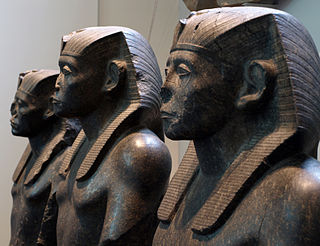This page is based on this
Wikipedia article Text is available under the
CC BY-SA 4.0 license; additional terms may apply.
Images, videos and audio are available under their respective licenses.

Amenemhat III, also spelled Amenemhet III, was a pharaoh of the Twelfth Dynasty of Egypt. He ruled from c. 1860 BC to c. 1814 BC, the highest known date being found in a papyrus dated to Regnal Year 46, I Akhet 22 of his rule. His reign is regarded as the golden age of the Middle Kingdom. He may have had a long coregency with his father, Senusret III.

The Middle Kingdom of Egypt is the period in the history of ancient Egypt following a period of political division known as the First Intermediate Period. The Middle Kingdom lasted from around 2050 BC to around 1710 BC, stretching from the reunification of Egypt under the reign of Mentuhotep II of the Eleventh Dynasty to the end of the Twelfth Dynasty. The Eleventh Dynasty ruled from Thebes and the Twelfth Dynasty ruled from el-Lisht. Some scholars also include the Thirteenth Dynasty of Egypt wholly into this period as well, in which case the Middle Kingdom would finish around 1650, while others only include it until Merneferre Ay around 1700 BC, last king of this dynasty to be attested in both Upper and Lower Egypt. During the Middle Kingdom period, Osiris became the most important deity in popular religion. The Middle Kingdom was followed by the Second Intermediate Period of Egypt, another period of division that involved foreign invasions of the country by the Hyksos of West Asia.

The Twelfth Dynasty of ancient Egypt, is often combined with the Eleventh, Thirteenth and Fourteenth Dynasties under the group title Middle Kingdom.

Sesostris was the name of a king of ancient Egypt who, according to Herodotus, led a military expedition into parts of Europe.

Amenemhat I, also Amenemhet I and the hellenized form Ammenemes, was the first ruler of the Twelfth Dynasty, the dynasty considered to be the golden-age of the Middle Kingdom of Egypt. He ruled from 1991 BC to 1962 BC.
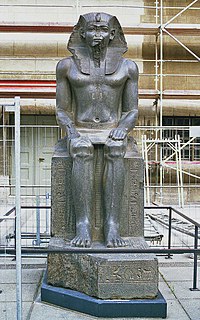
Nubkaure Amenemhat II was the third pharaoh of the 12th Dynasty of Ancient Egypt. Although he ruled for at least 35 years, his reign is rather obscure, as well as his family relationships.
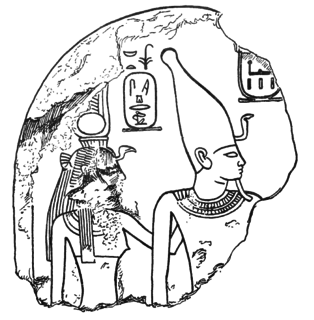
Meretseger was an Ancient Egyptian queen consort.

Khnumhotep III was an Ancient Egyptian high steward and vizier of the 12th Dynasty.
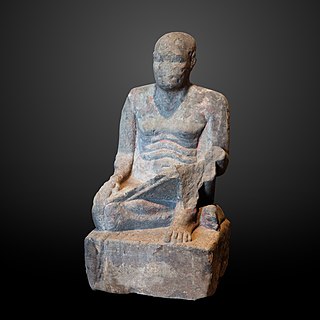
Mentuhotep was an Ancient Egyptian official and treasurer under the 12th dynasty pharaoh Senusret I. Mentuhotep is one of the best attested officials of the Middle Kingdom period. There is a series of statues found at Karnak, showing him as a scribe. On these he has been given the title of overseer of all royal works, which would suggest that he was involved in overseeing the construction of the temple at Karnak. At el-Lisht he had a large tomb next to the pyramid of Senusret I. When it was found it was badly damaged, but there are remains of high quality reliefs and fragments of statues. The burial chamber still contained two sarcophagi, one smashed and the other one well preserved, made of granite and with brightly painted interiors.
Senusret was an Ancient Egyptian official who was a vizier during the last years of king Senusret I's rule and in the first years of Amenemhet II. Senusret is known from a stela found in Abydos, which is dated to year 8 of Amenemhet II. He also appears in biographical inscriptions in the tomb of the governor Amenemhat at Beni Hasan, where it is reported that he was on a mission to Koptos. The inscription reports events under Senusret I.
Khenemetneferhedjet (ẖnm.t nfr-ḥḏ.t) was an ancient Egyptian queenly title during the Middle Kingdom. It was in use from the 12th to the early 18th dynasty. During the 12th dynasty it also occurred as a personal name. Its meaning is “united with the white crown”. The white crown was one part of the double crown of Egypt and is usually interpreted to have represented Upper Egypt, but it is also possible that while the red crown represented the king's earthly incarnation, the white crown represented the eternal, godlike aspect of kingship.
Sobekemhat was an Ancient Egyptian treasurer under the king Senusret III in the Twelfth Dynasty. Sobekemhat is only known from his mastaba excavated in 1894 next to the pyramid of Senusret III at Dahshur. The mastaba was decorated on the outside with reliefs. These were only found in small fragments, but the fragments record the name and the titles of Sobekemhat. On an offering table he bears the title of the treasurer. The mastaba is in a chain of three mastabas, north of the king's pyramid. It is closest to the pyramid. The next mastaba belongs to the vizier (Nebit) and the third to another high official, perhaps again a vizier. Therefore, it can be argued that Sobekemhat's tomb was the earliest of the three. For a long time it was thought that Sobekemhat was vizier, but the relief fragments with the vizier's title come from the mastaba of Nebit nearby.

Ikhernofret was an ancient Egyptian treasurer of the 12th Dynasty, under king Senusret III until the early years of Amenemhat III. On his monuments he bears several important titles, including overseer of the double treasury, overseer of the double gold house, royal sealer and his main title treasurer. Ihkernofret is known from several stelae found at Abydos. One of these stelae contains a biography. This stela is now in the Egyptian Museum of Berlin. According to its text, Ikhernofret grew up at the royal court. When he was 26, he became friend of the king, which was most likely a special honor. However, the text of the stela is of special importance as it reports the arrangement by Ikhernofret of a festival for Osiris at Abydos.

Djehutihotep was an ancient Egyptian nomarch of the fifteenth nomos of Upper Egypt during the twelfth dynasty, c. 1900 BC.
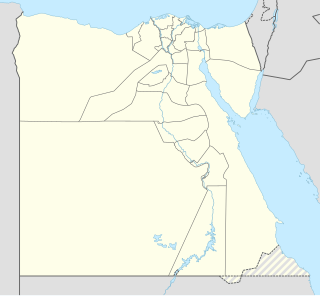
Mersa Gawasis is a small Egyptian harbour on the Red Sea and a former Egyptian port city. The harbour lies at the mouth of Wadi Gawasis, 2 km south of the mouth of Wadi Gasus. 25 km north is the city of Safaga and 50 km south al-Qusair.
Sobekhotep was an Ancient Egyptian treasurer in office under king Senusret I, around 1950 BC. The treasurer was one of the leading officials at the royal court, responsible for supplying the palace with all kinds of goods. Sobekhotep is only attested in a rock inscription in Hatnub in Middle Egypt where alabaster was quarried. The inscription dates to year 22 of the reign of Senusret I. Next to title treasurer, Sobekhotep bears the titles royal sealer and sole friend. His successor in office was perhaps Mentuhotep.

